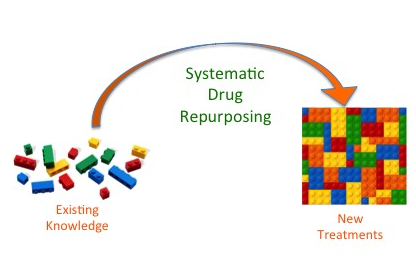
More than 5 years have now passed since the industry began using Systematic Drug Repurposing (SDR) as a tool for developing innovative, effective and affordable treatments. Starting off as a “nice-to-have” capability, SDR is increasingly being embraced by most large pharmaceutical companies but also by other stakeholders including patient advocacy and rare disease groups, as well as government organizations through targeted initiatives such as the MRC in the UK and NCATS in the US. So is SDR an interesting “experiment” or is it here to stay?
I think that SDR is here to stay, and here is why:
First, the demand for better and cheaper healthcare is showing no signs of slowing down. While the hope is that New Chemical Entities (NCEs) will continue providing new therapies, the cost of bringing a new asset to market has now passed the $2B mark (estimated average actual cash outlays plus time costs, according to a recent Tufts Center for the Study of Drug Development study). Yet, at the same time, the average forecasted peak sales are decreasing by more than 40%. For as long as it persists, this reality will perpetuate the need for more affordable solutions, both for mainstream and rare/orphan diseases where the financial proposition of drug repositioning can be rather compelling.
Second, the emergence of new challenges such as precision and personalized medicine, but also our desire to tackle complex diseases such as cancer and Alzheimer’s represent an R&D space that requires us to systematically and thoroughly combine our existing understanding of diseases with new types of data in a holistic, integrated way. This is a task for which certain resources and tools that are central to the drug repositioning “method” are well suited.

Third, there is the accelerating pace of discoveries and biotechnology innovation, which impacts the productivity of the R&D enterprise. More insights on biological processes and their potential interdependencies are being acquired at a higher pace and better tools for aggregating, analyzing and interpreting data are constantly being developed. Just like when you have more Lego bricks you can create more interesting structures, with more “information chunks” available to be combined and recombined with each other in new ways, you get more opportunities to deliver new therapies based on unexpected and monetizable uses of existing drugs. This becomes even more compelling if we think of such drugs as starting points to develop broader families of compounds, based on the repositioned drug biology and chemistry “core”.
Fourth, recognizing the benefits of collaboration, pharmaceutical companies are revisiting outsourcing as a way to tap into new insights on disease pathology and treatment development that are not subject to internal assumptions, viewpoints and other organizational limitations that may hinder innovation. Certain tools and resources used in SDR recognize these limitations and are therefore, by design, well aligned with this collaborative, outsourcing approach.
Fifth, companies are increasingly embracing the single tablet, combination therapy approach. Gilead’s Stribild for example, is a single pill combination of four medicines that is used as a complete HIV-1 treatment. Therapies delivered as a single pill that combines repositioned drugs can not only benefit the patient but also promise additional IP protection for the sponsor through a well targeted mix of “component of combination”, “new use” and “formulation” patents. The “component of combination” patent in particular represents a solid opportunity for protection since following the U.S. Supreme Court’s 2007 ruling (KSR v. Teleflex, 550 U.S., 2007), a combination has a better chance of being considered non-obvious and hence patentable if at least one of the elements being combined does not perform the function it was designed to perform (which is what a repositioned drug would be doing). The benefit/risk of pursuing combination therapies is well understood, and SDR helps reframe the risks and make such options more mainstream.
There are more reasons why SDR is here to stay and grow, including the “defense of the realm” perspective of not allowing competitors to capture new use IP on one’s own drugs. More than 10 new use patents publish every month, including major drug franchises being now owned in new uses by non-originators. Even drugs that have failed in clinical trials and are usually abandoned are now starting points for new discovery. In an interesting twist of business logic, the originators of such failures are sometimes not pursuing any form of value recapture, thus opening the door to competitors. For example, the Massachusetts Eye and Ear Infirmary’s published patent WO/2014/037412 claims Lilly’s semagacestat and BMS’s avagacestat, failed Alzheimer’s drugs, in hearing loss, which is a major market. As a result, Lilly and BMS are now actively blocked from this market with their own drugs.
SDR cannot provide all the answers to our healthcare needs, and clearly developing NCEs will continue to be the pharmaceutical industry’s primary objective. But as long as the present harsh economic reality persists, and as we take on new big-ticket challenges, we will need to ensure that we effectively and systematically assess all the potential applications of any piece of hard-earned knowledge. Approaches to innovation such as SDR will therefore continue to have a place in the pharmaceutical industry’s toolbox.

